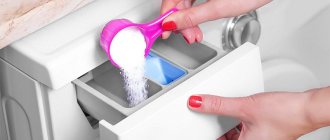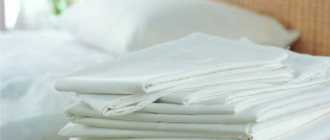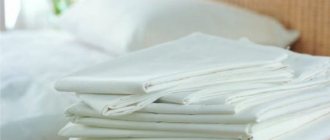Why do you need to starch things?
The starching process not only gives things, including bed linen, a pleasant crunch and a fresh appearance. Still, the functional component is also present here. After treating the fabric with starch, a thin film remains on the product, which creates that same “crunch” effect. In this case, the item becomes easier to iron, and it retains its shape for a fairly long period of time. In addition, starched fabric is more difficult to stain: of course, starch does not repel dirt and dust, but the substance does not allow dirt to penetrate deep into the fibers of the fabric.
Useful tips
It is important to know that not all fabrics can be treated with a paste substance. It is permissible to starch only products made from natural materials: linen, cotton, chintz, calico, satin, cambric. Silk and synthetic underwear cannot be starched.
Let us present to your attention the procedure for preparing a starch solution, which can be used for both automatic and manual washing. Here's a step-by-step guide to action.
- Dissolve starch in cool water. For 1 liter of liquid you need to take a quarter teaspoon of powder.
- Boil water in another saucepan, then carefully pour starch milk into the boiling water in a thin stream, stirring constantly.
- Reduce heat and cook the paste for 5 minutes. The solution should turn out transparent, similar in consistency to regular jelly.
- Cool the starch paste.
- If there are lumps in the composition, strain the sticky liquid using a sieve.
Before starching the laundry, the paste is diluted with ordinary cool water to the required consistency. If you want to give your laundry an interesting blue tint, you can add a little blue to the adhesive solution.
A spoonful of salt added to the paste will give your accessories a glossy shine after ironing. Table salt will also help the products not to freeze when dried in the fresh air in winter. Another useful tip: to prevent starched material from sticking to the sole of the iron, it is better to add 3 drops of turpentine or 0.5 caps of liquid laundry gel to the adhesive composition.
Types of starching
There are three types of starching, which vary depending on the intensity of the procedure:
- Soft starching,
- Medium starching
- Hard starching.
For example, underwear, bed linen, bedding, light blouses and dresses are softly or very softly starched; Men's shirts and tablecloths are moderately starched, but hard starching is used in the case of partial processing - for cuffs, collars and other elements of clothing. At the same time, the amount of starch per liter of water varies.
We carry out the processing procedure
Don’t worry that preparing the solution itself, then the processing procedure, are difficult and time-consuming.
You need to remember what benefits this will give, and after doing everything necessary once or twice and getting acquainted with the result, no one will want to give it up.
Consists of several stages:
- Take a large container to fit the laundry;
- Pour the solution, it should be warm;
- Load all accessories;
- Leave for 20 minutes;
- If the container allows and there is a desire, you can not soak, but rinse things thoroughly;
- Squeeze, but you shouldn’t overdo it, as the fabric didn’t have any strong creases;
- Shake well and hang to dry.
There is no need to wait until the fabric is completely dry; it is better to iron the bedding slightly damp.
During ironing, the iron temperature should be medium or low. High temperature will ensure adhesion during ironing.
Over-dried bedding is much more difficult to iron. You can simplify this moment with the help of water, which is sprinkled on the fabric!
What type of starch should I use?
For starching, as the name implies, starch is used. But which one? The modern product market offers the following types of starch:
- Potato starch,
- Corn starch,
- Wheat starch,
- Rice starch.
The different types of starches look almost identical. Yes, and they differ greatly only for cooking, but when starching, their properties are very similar. The only difference is the degree of density of the substance obtained during dilution. Of the above types, it is potato starch that performs best, which, however, is one of the most popular and widespread types of starch, which is sold everywhere in our stores.
How to do it manually?
To starch bed linen manually, you first need to properly prepare the starch solution. To do this, you will need the starch itself. To determine the amount of a component, you need to know exactly what concentration of solution is needed. So, for a hard procedure you will need 2 tablespoons of starch, for a medium one – 1 tablespoon, and for a soft one – 1 teaspoon.
If we talk about which starch is best suited for the procedure, then it is potato starch. It shows itself best in the process of work and, plus everything, is freely available. However, if you use corn, wheat or rice starch, it doesn’t matter. They are also suitable for starching products. All varieties of starch have similar properties and differ only in their degree of thickness when preparing solutions.
Article on the topic: Where to return a washing machine in Omsk
The required amount of the component is mixed with 200 milliliters of cool water and mixed so that there are no lumps left in the solution. Otherwise, the mixture must be additionally strained through a strainer or cheesecloth.
Separately, you need to boil an additional 800 milliliters of water and carefully pour the starch mixture into it. Pour it in in a thin stream, stirring constantly. Overall the mixture is almost ready. If it comes out too thick, add a little warm water to achieve the desired consistency. Next, the resulting solution is cooled and the procedure itself begins.
Before starching a product, it must first be washed and rinsed. To starch bed linen manually, without the help of a washing machine, you need to pour the starch solution into a large container and place the product itself there so that it is completely wet. After this, the item needs to be pulled out, squeezed thoroughly and sent to dry.
Please note that it is not recommended to send starched items to dry in cold air; it is better to leave them to dry in a warm room.
To starch an item correctly, it is worth considering some factors. So, if the item is made of delicate material, it needs to be placed in the mixture for just a few seconds. Openwork items take longer to starch, about 20 minutes. Bed linen, napkins and other things of this type should remain in the solution for about 15 minutes.
If you want to starch not the entire thing, but only part of it, apply the prepared starch mixture to the desired area, wait 20 minutes and go over this area with an iron.
Article on the topic: How to wash 100 polyester in a washing machine
How to starch bed linen?
It is recommended to starch bed linen using a gentle method. Before proceeding with the procedure, wash your clothes in the usual way - by hand or in a washing machine. Next, you should either squeeze the laundry well (this will not be difficult if you use a washing machine) or dry it completely. Thus, the linen must be pre-prepared - it must be clean and fresh so that the starching procedure does not go in vain.
Next, you should prepare the solution. With soft starching, the liquid is prepared as follows:
- Take starch in a ratio of one teaspoon to one liter of water and pour it into a glass,
- Pour cold water over the starch and mix thoroughly until a single liquid is formed without lumps,
- Boil the amount of water required for rinsing (based on which you calculated the amount of starch),
- When the water boils, pour the dissolved starch into it, stirring the water constantly.
- Cool the resulting solution, in which you will rinse your bed linen.
What should the starch liquid be like?
Without lumps, homogeneous, quite dense compared to ordinary water and even a little “slippery”.
The starching procedure itself is incredibly simple: you place clean bed linen (either dry or wet) in the prepared liquid, leave for a couple of minutes, rinse and remove. You shouldn’t twist the product too much after this, just let the linen hang and then wring it out. To make ironing your bedding easier, be sure to shake things before hanging them to dry and never over-dry starched linen.
Features of starching in a washing machine
If you were wondering how to starch laundry in a washing machine, and whether it can be done, the answer is, of course, yes. Moreover, this is a very simple procedure that even a novice housewife can handle.
It looks like this:
- Prepare a starch-based composition. If you don’t want to bother preparing it, you can buy ready-made in the store, for example, Luga or other powdered form. See the label for details of the proportions.
- Select the appropriate program in the machine, add the powder, and pour the prepared mixture into the rinse aid compartment.
- Launch the program.
- After finishing washing, remove the laundry from the washing machine, shake and hang to dry. Then, when it is slightly damp, iron it.
- To extend the life of the machine, it is recommended to turn on the rinsing program; this is necessary so that the composition does not harden on the internal parts. Rinse the container where the powder is poured under running warm water, and wipe the drum with a dry cloth.
- Leave the door open to allow everything to dry thoroughly.
An easy way to starch bed linen
If you have already washed and dried your bed linen and have no desire to get it wet again, put a weak solution of starching liquid into a spray bottle and spray the substance onto clean bed linen. This way you will save your own time and effort.
Moreover, the modern product market offers products that will almost certainly make the life of every housewife easier. Today, the starching process is simplified in the following two ways:
- Starch agent, which is added directly during washing,
- Spray for applying starch before ironing.
Both methods are convenient because they allow housewives to forget about preparing the solution and fiddling around at the stove.
Starch the traditional way
You can give your linen incredible freshness and “squeaky” cleanliness using the classic method of starching, which our grandmothers told us about. To carry out the procedure manually, at home, you should perform the following sequence of actions:
Article on the topic: Is it possible to wash nubuck shoes in a washing machine?
- Place the washed items in a basin with a cool starch solution (not hotter than 35 °C);
- leave the products in the container for 15-20 minutes. If you don’t have that much time, you can simply rinse your clothing or bedding thoroughly in the solution;
- lightly wring out the laundry and shake it to prevent wrinkles from forming on the fabric;
- dry the products.
Ironing starched clothes or bedding is done when the linen is slightly damp . It is important to set the minimum heating temperature for the soleplate of the iron; this measure will prevent the fabric from sticking to the metal.
If the traditional starching procedure seems too complicated, you can use another method. Prepare a weak paste, pour the liquid into a spray bottle and spray the laundry that has already been cleaned and prepared for ironing. This method will take much less time and will simplify starching of large items.
Why shouldn't you starch your bed linen?
Some experts do not recommend starching bedding. And their fears are completely justified. The most important reason is that starched linen stops breathing because the starch clogs the holes between the fibers. Why is this a real problem for bedding specifically? A person spends a third of his life in bed, and at night the human body secretes sweat. If the fabric does not breathe, does not allow air to pass through and does not absorb liquids, this threatens a person not only with unpleasant sensations, but also with the risk of developing fungus and mold in the bed, as well as creating a favorable atmosphere for the invasion of unpleasant insects and bacteria.











